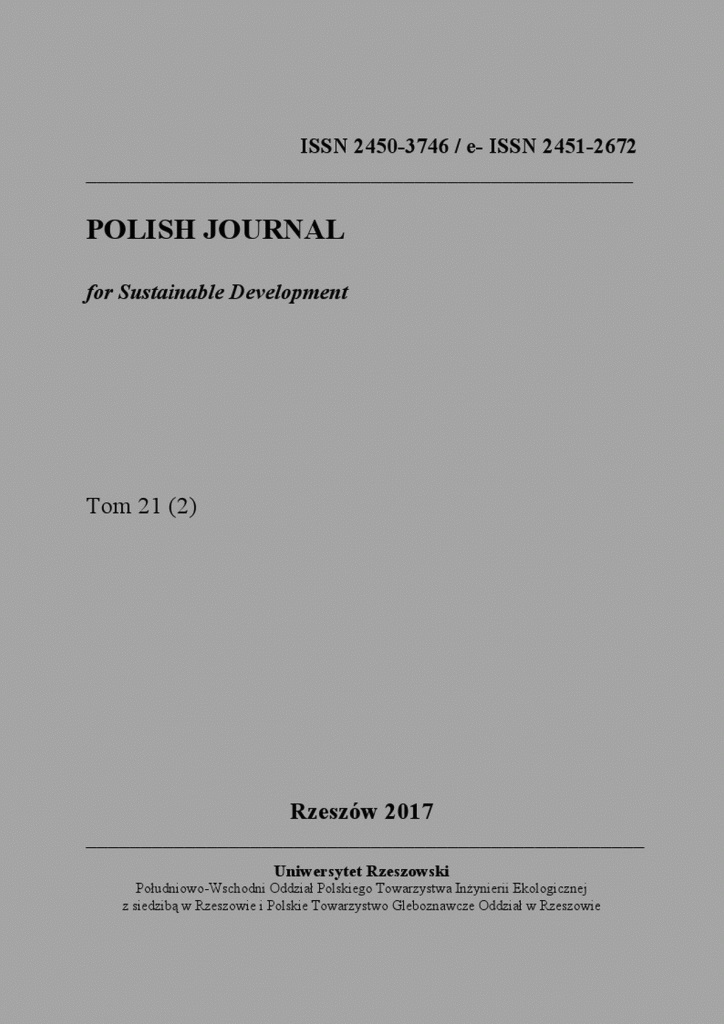Blaski i cienie światła niebieskiego
DOI:
https://doi.org/10.15584/pjsd.2017.21.2.16Słowa kluczowe:
światło niebieskie, melatonina, oddziaływanie, człowiekAbstrakt
W widmie promieniowania widzialnego pasmo światła niebieskiego zawiera się w przedziale od ok. 440 nm do ok. 490 nm. Od ok. 2000 r. zaczęły pojawiać się doniesienia naukowe wykazujące na istotne znaczenie światła niebieskiego dla uprawy roślin, dla zdrowia człowieka i jego chronobiologii. Wykazano, że światło niebieskie może wpływać zarówno pozytywnie na stan zdrowia człowieka (leczenie zaburzeń snu i cyklu okołodobowego, poprawa sprawności psychofizycznej i czujności) jak i negatywnie (potencjalne uszkodzenie fotochemiczne siatkówki oka, rozwój nowotworów hormonozależnych). Artykuł przedstawia wybrane aspekty sposobu oddziaływania światła niebieskiego na organizm człowieka oraz skutków ekspozycji na to światło. Skutków zarówno pozytywnych jak i negatywnych.
Downloads
Bibliografia
Aube M., Roby J., Kocifaj M. 2013. Evaluating potential spectra impacts of various artificial lights on melatonin suppression, photosynthesis, and star visibility. PLOS ONE. 8(7). 67798.
Behar-Cohen F., Martinsons C., Vienot F., Zissis G., Barlier-Salsi A., Cesarini J.P. 2011. Light emitting diodes (LED) for domestic lighting: Any risks for the eye? Progress in Retinal and Eye Research. 30. 239-257.
Blask D.E., Dauchy R.T., Brainard G.C., Hanifin J.P. 2009. Circadian stage-dependent inhibition of human breast cancer metabolism and growth by the nocturnal melatonin signal: consequences of its disruption by light at night in rats and women. Integr. Cancer Ther. 8(4). 347-53.
Brainard G.C., Hanifin J.P., Greeson J.M., Byrne B., Glickman G., Gerner E. 2001. Action spectrum for melatonin regulation in humans: Evidence for a novel circadian photoreceptors. J. Neurosci. 21(16). 6405-6412.
Cipolla-Neto J., Amaral F.G., Afeche S.C., Tan D.X., Reiter R.J. 2014. Melatonin, energy metabolism, and obesity: a review. Journal of Pineal Research. 56(4). 371-381.
Digital eye strain report. 2015. Hindsight is 20/20/20: Protect your eyes from digital devices. The Vision Council. Alexandria. USA.
Figueiro M.G., Bullough J.D., Rea M.S. 2015. Spectra sensitivity of the circadian system. Lighting Research Center. [dok. elektr.: www.lrc.rpi.edu/programs/lightHealth/pdf/spectralSensitivity.pdf. data wejścia 8.10.2016]
Karasek M. 2007. Znaczenie kliniczne melatoniny. Postępy Nauk Medycznych. 10. 395-398.
Lavoie S., Paquet J., Selamoui B. Rufiange M., Dumont M. 2003. Vigilance levels during and after bright light exposure in the first half of the night. Chronobiology International. 20(6). 1019-1038.
Lehmann G. 1996. Praktyczna fizjologia pracy. PZWL. Warszawa.
Lockley S.W., Evans E.E., Scheer F.A., Brainard G.C., Czeisler C.A., Aeschbach D. 2006. Short-wavelength sensitivity for the direct effects of light on alertness, vigilance, and the waking electroencephalogram in humans. Sleep. 29(2). 161-168.
Lucas R.J., Peirson S.N., Berson D.M., Brown T.M., Cooper H.M., Czeisler C.A. i in. 2014. Measuring and using light in the melanopsin age. Trends Neurosci. 37(1). 1-9.
Paul M.P., Miller J.C., Gray G., Buick F., Blazeski S., Arendt J. 2007. Circadian phase delay induced by phototherapeutic. Aviat. Space Environ. Med. 78(7). 645-652.
Piazena H.F, Franke L., Uebelhack R., Kockott D., Volker S. 2010. Light-controlled melatonin suppression considering person’s age. Abstract Booklet of CIE Conference Light Quality & Energy Efficiency. March 14-17. 2010. Vienna. Austria. OP31.
Rahman S.A., Flynn-Evans E.E., Aeschbach D., Brainard G.C., Czeisler C.A., Lockley S.W. 2014. Diurnal spectral sensitivity of the acute alerting effects of light. Sleep. 1. 37(2). 271-81.
Richter K., Acker J., Kamcev N., Bajraktarov S., Piehl A., Niklewski G. 2011. Recommendations for the prevention of breast cancer in shift Wolkers. EPMA Journal. 2(4). 351-356.
Sahin L., Figueiro M.G. 2013. Alerting effects of short-wavelengths (blue) and long – wavelengths (red) lights in the afternoon. Physiology&Behaviour. 116-117(5). 1-7.
Srinivasan V., Maestroni G.J., Cardinali D.P., Esquifino A.I., Pandi-Perumal S.R., Miller S.C. 2005. Melatonin, immune function and aging. Immunity & Ageing. 2(17).
Thapan K., Arendt J., Skene D. 2001. An action spectrum for melatonin suppression: Evidence for a novel non-rod, non-cone photoreceptor system in humans. J. Physiol. 535. 1. 261-267.
Treder J., Sowik I., Borkowska A., Klamkowski K., Treder W. 2014. Aklimatyzacja mikrosadzek truskawki z zastosowaniem doświetlenia lampami LED. Materiały VI Konferencji Promieniowanie Optyczne, Oddziaływanie, Metrologia, Technologie POOMT. Baranów Sandomierski. 28-30 maja 2014. 299-305.
Viola A.U., James L.M., Schlangen L.J., Dijk D.J. 2008. Blue-enriched white light in the workplace improves self-reported alertness, performance and sleep quality. Scand J. Work Environ. Health. 34(4). 297-306.
West K.E., Jablonski M.R., Warfield B., Cecil K.S., James M., Ayers M.A. 2011. Blue light from light-emitting diodes elicits a dose-dependent suppression of melatonin in humans. J. Appl. Physiol. (1985). 110(3). 619-26.
Wolska A., Sawicki D., Tomczuk K., Mazurek P. 2016. Rozkład widmowy światła sztucznego a skuteczność hamowania wydzielania melatoniny. Przegląd Elektrotechniczny. 92(9). 186-190.
Wolska A., Zużewicz K. 2015. Barwa światła a poziom czujności człowieka. Przegląd Elektrotechniczny. 91(7). 77-80.
Wood B., Rea M.S., Plitnick B., Figueiro M.G. 2013. Light level and duration of exposure determine the impact of self-luminous tablets on melatonin suppression. Applied Ergonomics. 44(2). 237-240.
Zawilska J.B, Czarnecka K. 2006. Melanopsyna – nowo odkryty chronobiologiczny receptor światła. Postępy Biologii Komórki. 33(2). 229-246.
Rozporządzenie Ministra Pracy i Polityki Socjalnej z dnia z 6 czerwca 2014 r. w sprawie najwyższych dopuszczalnych stężeń i natężeń czynników szkodliwych dla zdrowia w środowisku pracy. (DzU z 2014 poz. 817).
PN-EN 14255-2:2010. Pomiar i ocena ekspozycji osób na niespójne promieniowanie optyczne. Część 2: Promieniowanie widzialne i podczerwone emitowane przez źródła sztuczne na stanowisku pracy.
PN-EN 62471:2010. Bezpieczeństwo fotobiologiczne lamp i systemów lampowych.
Pobrania
Opublikowane
Numer
Dział
Licencja
Prawa autorskie (c) 2017 Polish Journal for Sustainable Development

Utwór dostępny jest na licencji Creative Commons Uznanie autorstwa – Użycie niekomercyjne – Bez utworów zależnych 4.0 Międzynarodowe.


